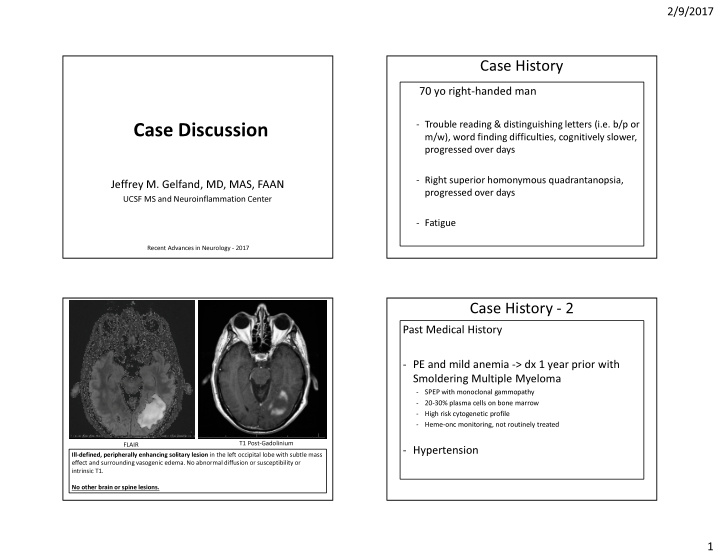



2/9/2017 Case History 70 yo right-handed man - Trouble reading & distinguishing letters (i.e. b/p or Case Discussion m/w), word finding difficulties, cognitively slower, progressed over days - Right superior homonymous quadrantanopsia, Jeffrey M. Gelfand, MD, MAS, FAAN progressed over days UCSF MS and Neuroinflammation Center - Fatigue Recent Advances in Neurology - 2017 Case History - 2 Past Medical History - PE and mild anemia -> dx 1 year prior with Smoldering Multiple Myeloma - SPEP with monoclonal gammopathy - 20-30% plasma cells on bone marrow - High risk cytogenetic profile - Heme-onc monitoring, not routinely treated T1 Post-Gadolinium FLAIR - Hypertension Ill-defined, peripherally enhancing solitary lesion in the left occipital lobe with subtle mass effect and surrounding vasogenic edema. No abnormal diffusion or susceptibility or intrinsic T1. No other brain or spine lesions. 1
2/9/2017 Key Diagnostics Stereotactic Brain Biopsy LABS - SPEP with monoclonal gammopathy, IgG 1900 (normal <1760) - Elevated free lamda light chains (222, normal <26), LDH normal - HIV negative, RPR NR, HTLV neg “Macrophage-rich demyelinating lesion” - NMO (AQP4) IgG neg; ANA neg Foamy macrophages and scattered reactive astrocytes, some of which BODY IMAGING have mildly enlarged and hyperchromatic nuclei. - CT Chest/Abd/Pelvis: No malignancy - FDG-PET: Brain lesion is hypermetabolic, no other FDG-avid disease Complete loss of myelin, with relative preservation of axons CSF EXAM Opening Pressure: 14 cm Many macrophages, no B lymphocytes, small mature perivascular T 2 WBC (53%L, 47% Monos, no eos, no polys) lymphocytes, no malignancy 0 RBC Protein 54 (mildly elevated) Negative for polyoma virus (i.e. negative for PML) Glucose 72 (serum 120) IgG index 0.5 1 unique oligoclonal band Cytology/Flow cytometry: Benign JCV PCR negative Tumefactive Demyelinating Lesions (TDLs) Cystic Incomplete Rim TDLs: Atypical inflammatory- demyelinating lesions >2 cm -1-2/1000 cases of MS; also associated with “ADEM”, NMO, HIV, connective tissue disease or as a stand-alone Solid Nodular diagnosis Relapse risk highly variable in literature; esp high if otherwise have MS Patchy FLAIR T1 Post Gadolinium Balo-Like Of 31 biopsy-confirmed cases at UCSF, 2 were REPEAT MRI SIX WEEKS LATER, improved, no new lesions, resolution of abnormal malignant diagnoses (glioma, enhancement lymphoma). Up to 50% with f/u relapsed, 3 with Treated with oral glucocorticoids, down to 0.5 mg/day dexamethasone. Language recurrent TDLs. much improved. Prominent right homonymous hemianopsia. No new symptoms. Tremblay, Villanueva-Meyer, Cha, Tihan and Gelfand, et. al. In preparation 2
2/9/2017 What is the diagnosis? Follow-up Solitary Tumefactive Demyelinating Lesion – but why? • 8 months later -> Localization-related Seizures (flashing green - ?Clinically Isolated Syndrome (i.e. MS disease spectrum)? lights right visual field, aphasia, confusion, then generalized - ?“Paraneoplastic” Disorder, secondary to smoldering myeloma? - ?Malignancy tonic-clonic) - ?Infection • MRI stable (no new or active lesions) What is the treatment? • EEG : Left temporal slowing, intermittent epileptiform discharges midtemporal region - ?Watch and wait - ?Repeat biopsy - ?MS Disease Modifying Therapy • Repeat CSF bland -> 1WBC (81% L, 16% M), 20 RBC, protein - ?Other immunosuppressive therapy 64, glucose 67 (serum 130), IgG Index 0.5, matched bands but - ?Antibiotics no unique oligoclonal bands, cytology/flow cytometry benign LABS - SPEP with monoclonal gammopathy, IgG 1900 ->3310 - Bone Marrow with 30-40% plasma cells, lambda monotypic with atypia and plasma cell aggregates - LDH normal, ESR normal, ANA neg BODY IMAGING - CT Chest/Abd/Pelvis: Segmental Pulmonary Emboli , no malignancy - FDG-PET: Unremarkable - MRI Total Spine: Diffuse heterogenous bone marrow signal with mottled enhancement. New endplate compression fractures (T8-12) CSF EXAM: - 9 WBC (90%L), protein 54 , glucose 60, IgG index 0.6, matched bands, benign cytology and flow cytometry 10 months later: Subacute Ataxia, Vertigo. 1) Transformed to Multiple Myeloma (Stage 2) : treatment initiated 2) Relapsing-Remitting Demyelinating Disease – ?MS, paraneoplastic, coincidental? Temporally correlated with transition from MRI new right cerebellar peduncular lesion extending adjacent to the 4 th ventricle. Enhancing. Demyelinating etiology favored. smoldering to relapsing myeloma. No further CNS inflammatory activity on myeloma therapy. 3
Recommend
More recommend